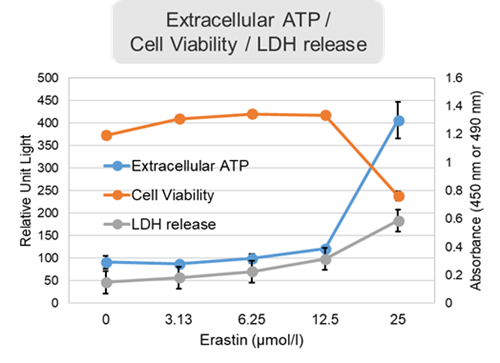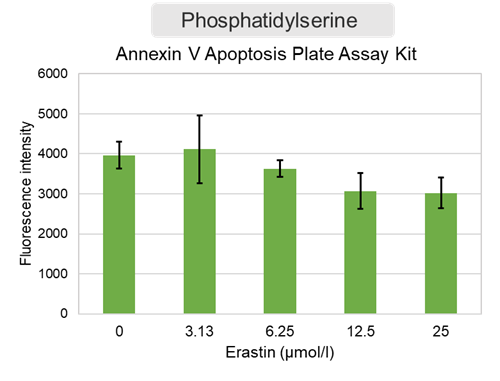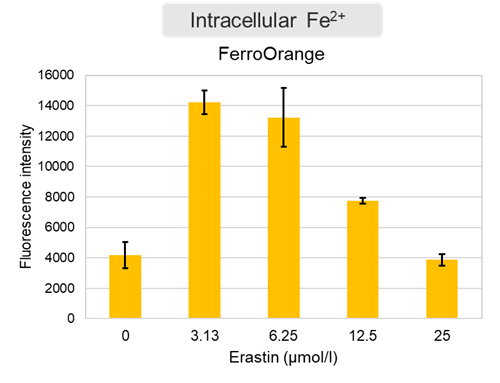Extracellular ATP Assay Kit-Luminescence

Extracellular ATP Assay Kit-Luminescence
- Simply add luminescent reagents to samples for measurement.
- Easier to perform assays with detailed protocols.
- Multiple indicators can be measured in combination with other Dojindo's kits.
-
Product codeE299 Extracellular ATP Assay Kit-Luminescence
| Unit size | Price | Item Code |
|---|---|---|
| 100 tests | Find your distributors | E299-10 |
| 100 tests | Enzyme Solution Substrate eATP Assay Buffer |
20 µl×1 ×1 11 ml×1 |
|---|
Analysis of cell death in detail
Cell death has been the subject of research for many years because of its role in the pathogenesis of several diseases. Traditionally, cell death has been divided into two types, apoptosis and necrosis, depending on the situation and the stimulus that triggers its induction. In recent years, however, cell death that follows a different pathway from apoptosis and necrosis, such as ferroptosis and autophagic cell death, has been discovered. Detailed analysis of cell death pathways is being conducted to develop treatments for diseases.
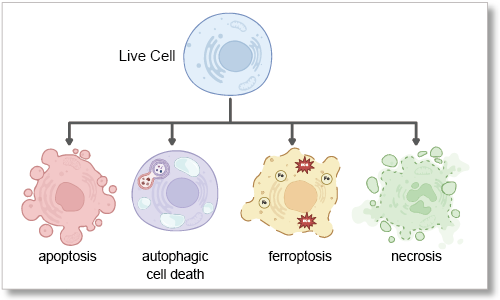
Description
(1) Same sample can be evaluated with multiple indicators.
Measuring both cells and supernatant with different indicators enables a more detailed analysis of cell death.
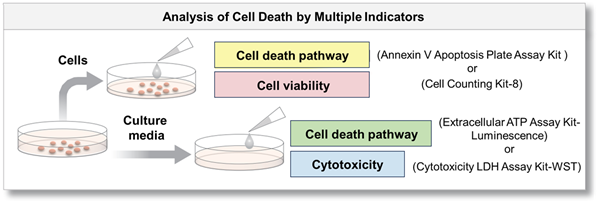
(2) More accurate measurement protocol
ATP release into the extracellular space is highly sensitive and can occur even after medium changes or pipetting. This kit allows first-time users to measure extracellular ATP changes due to stimulation using the luciferase luminescence method, with a protocol that accounts for measurement influences.

Manual
Technical info
Adenosine triphosphate (ATP), produced through glycolysis and in mitochondria, is a vital energy source for living cells. Meanwhile, ATP in the extracellular compartment is one of the damage-associated molecular patterns (DAMPs) released from damaged or dying cells, and extracellular ATP serves as a key messenger for cell-to-cell communication in processes like neurotransmission, cell growth, inflammation, and immune responses. Recent studies have suggested that cellular senescence in human lung fibroblasts is induced through ATP released by oxidative stress. In addition, because extracellular ATP is released in the early stages of cell death, it is also attracting attention to elucidating the detailed mechanisms of cell death such as necroptosis and pyroptosis.
The Extracellular ATP Assay Kit-Luminescence enables the detection of ATP in cell culture supernatant. This kit is formatted for 96-well microplates, allowing multiple sample measurements.
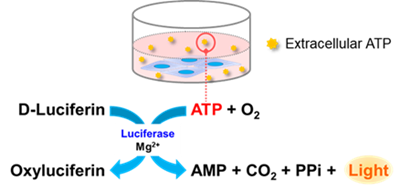
Experimental Example: Evaluation using Staurosporine-treated cells
HeLa and A549 cells were treated with Staurosporine, and extracellular ATP release and cell viability were assessed over time. The results showed that the extracellular ATP release of each cell differed in amount and timing depending on the cell type.
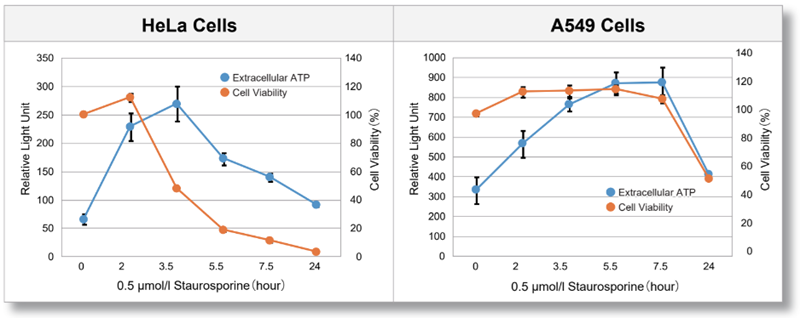
<Product in use>
Extracelluar ATP : Extracellular ATP Assay Kit-Luminescence (code:E299)
Cell viability : Cell Counting Kit-8(code:CK04)
Experimental Example: Evaluation using apoptosis inhibitors
Jurkat cells were treated with or without Z-VAD, an apoptosis inhibitor, and then treated with staurosporine. After treatment, changes in extracellular ATP release, cell viability and extracellular LDH release were assessed over time. The results showed that cell death was inhibited by Z-VAD, but extracellular ATP released during the initial phase of apoptosis increased over time.
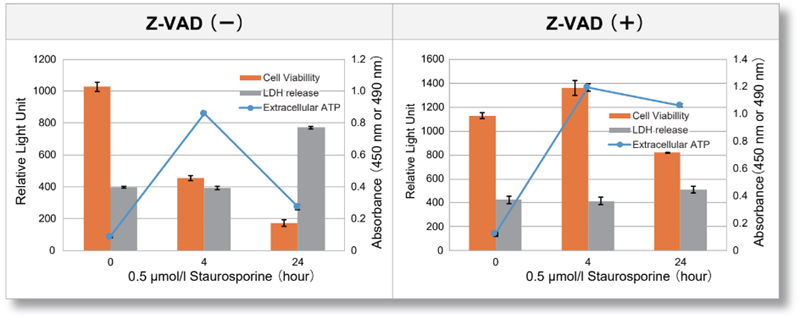
<Product in use>
Extracelluar ATP : Extracellular ATP Assay Kit-Luminescence (code:E299)
Extracellular LDH : Cytotoxicity LDH Assay Kit-WST(code:CK12)
Cell viability : Cell Counting Kit-8(code:CK04)
Experimental Example: Evaluation using Different drugs
Jurkat cells were treated with staurosporine or doxorubicin and changes in extracellular ATP release, cell viability and extracellular LDH release were assessed over time.The results showed that extracellular ATP was maximal at 4 hours in staurosporine-treated cells and at 24 hours in doxorubicin-treated cells. These results confirm that there are differences in the behaviour of extracellular ATP release depending on the drug.
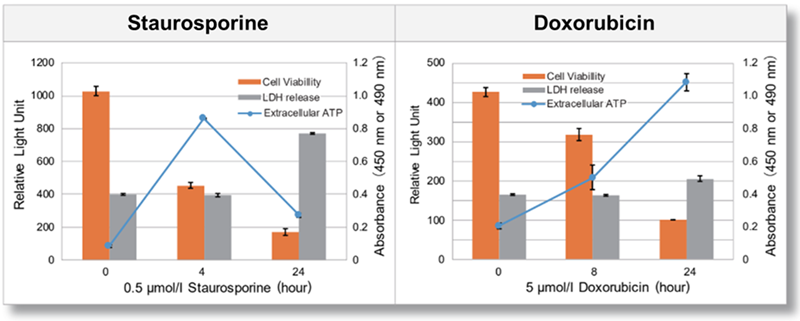
<Product in use>
Extracelluar ATP : Extracellular ATP Assay Kit-Luminescence (code:E299)
Extracellular LDH : Cytotoxicity LDH Assay Kit-WST(code:CK12)
Cell viability : Cell Counting Kit-8(code:CK04)
Experimental Example: Evaluation using Erastin-treated cells
-
Changes in extracellular ATP release, cell viability, extracellular LDH release, phosphatidylserine, and intracellular Fe2+ were evaluated in HeLa cells treated with various concentrations of Erastin, a ferroptosis inducer, for 24 hours. The results showed that cell viability decreased and extracellular ATP release and extracellular LDH increased in cells treated with Erastin concentration of 25 μmol/l, indicating that cell death was induced under high concentration conditions. Interestingly, the increase in extracellular ATP in the early phase of stimulation, which was observed with the apoptosis inducer Staurosporine, was not observed with Erastin (See Experimental Example: Evaluation using Staurosporine-treated Cells.). Although the apoptosis-related marker phosphatidylserine was not significantly altered by Erastin treatment at any concentration. The amount of intracellular Fe2+, a ferroptosis-related marker, was significantly increased under the low-concentration treatment condition, indicating that it tends to increase before actual cell death occurs.
<Product in use>
Extracellular ATP : Extracellular ATP Assay Kit-Luminescence (code:E299)
Extracellular LDH : Cytotoxicity LDH Assay Kit-WST(code:CK12)
Cell viability : Cell Counting Kit-8(code:CK04)
Phosphatidylserine : Annexin V Apoptosis Plate Assay Kit(code:AD12)
Intracellular Fe2+ : FerroOrange(code:F374)
Q & A
-
Q
How many samples can be tested by one kit?
-
A
If each sample is measured in triplicate, a maximum of 32 samples can be measured.

-
Q
How about the stability of luminescence signals?
-
A
The luminescent signal gradually decreases over time.
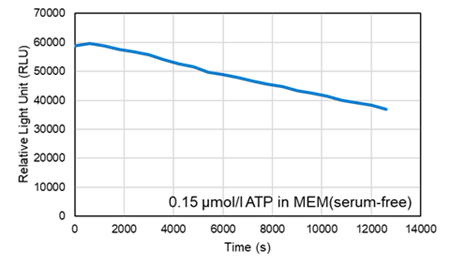
-
Q
May I use color plates other than white plates for measurement?
-
A
Please use 96-well white plate for luminescence detection.
We have tested with the following white microplates.Company Product name Bottom Cat No. SUMITOMO BAKELITE White plate for luminescence measurement with lid White
MS-8096W Thermo Scientific 96 Well White/Clear Bottom Plate, TC Surface Clear 165306 SPL Life Sciences SPL Cell Culture Plate 96 Well / Flat / White / Surface Treatment+ White 30196 Greiner CELL CULTURE MICROPLATE, 96 WELL, PS, F-BOTTOM Clear 655098 *Although measurements can be performed with plates other than white, the luminescence intensity will be lower when black or transparent plates are used. In addition, the blank will be higher with transparent plates, so 96-well white microplates are recommended.
-
Q
Can I store the measurement sample?
-
A
No, ATP is unstable and cannot be stored. Please perform ATP Assay immediately after collecting cell culture supernatant.
-
Q
Can I store the working solution?
-
A
Yes. After the preparation, the Working solution is stable at - 20 ℃ for approximately 30 days. Avoid freeze-thaw cycles to prevent degradation of the solution; aliquot it into micro tubes and store at -20ºC.
-
Q
What is the wavelength of the luminescence measurement?
-
A
This kit uses firefly luciferin, the luminescence measurement wavelength is 556 nm.
-
Q
Can I use a serum-containing medium?
-
A
If the medium contains serum, ATP released from the cells is more likely to be degraded; therefore, we recommend the use of serum-free medium. When using a medium containing serum, we recommend the use of a medium prepared so that the serum content is 1% or less.
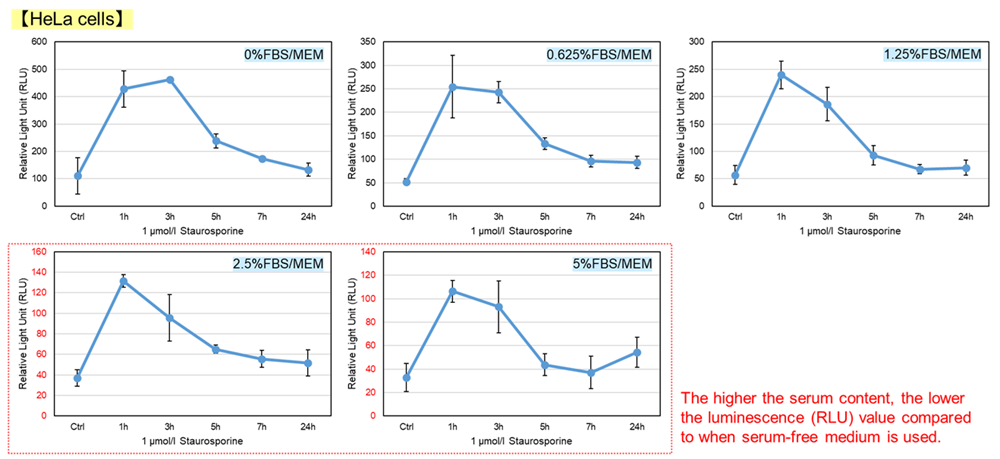
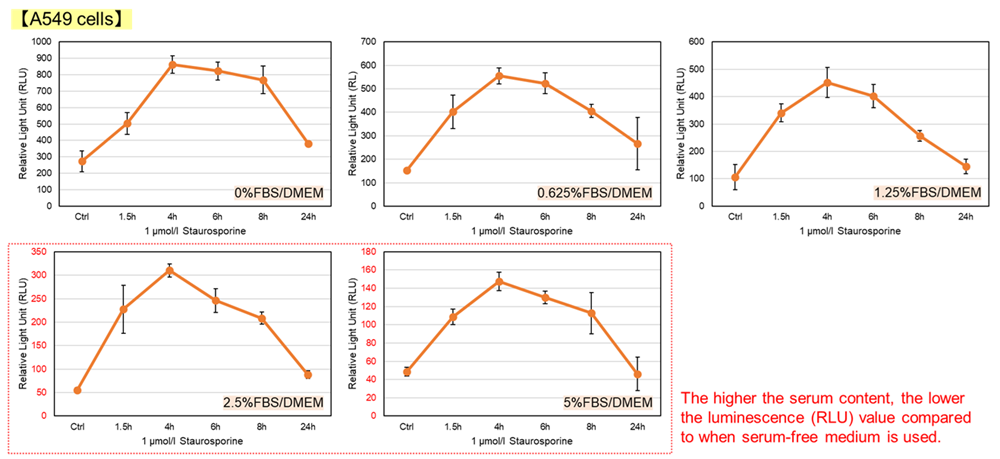
-
Q
Is centrifugation necessary after collecting the cell culture supernatant?
-
A
No centrifugation is required for either adherent or floating cells. Note: Allow floating cells to settle to the bottom of the plate before transferring the supernatant to a white 96-well microplate.
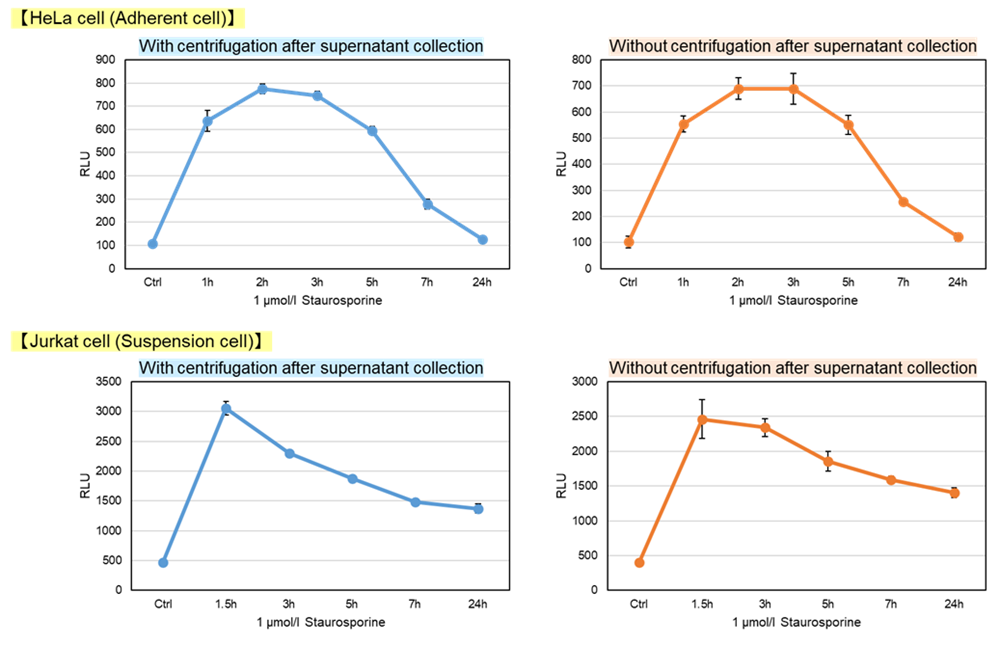
-
Q
Is it acceptable to collect suspended cells once after drug treatment in a microtube, etc. and use the supernatant after centrifugation for the ATP Assay?
-
A
When performing an extracellular ATP Assay, if pipetting is performed with cells present, ATP will be released due to the effect of pipetting. Since extracellular ATP cannot be accurately measured, do not collect the cells. Collect only the supernatant after the drug treatment and perform the ATP Assay.
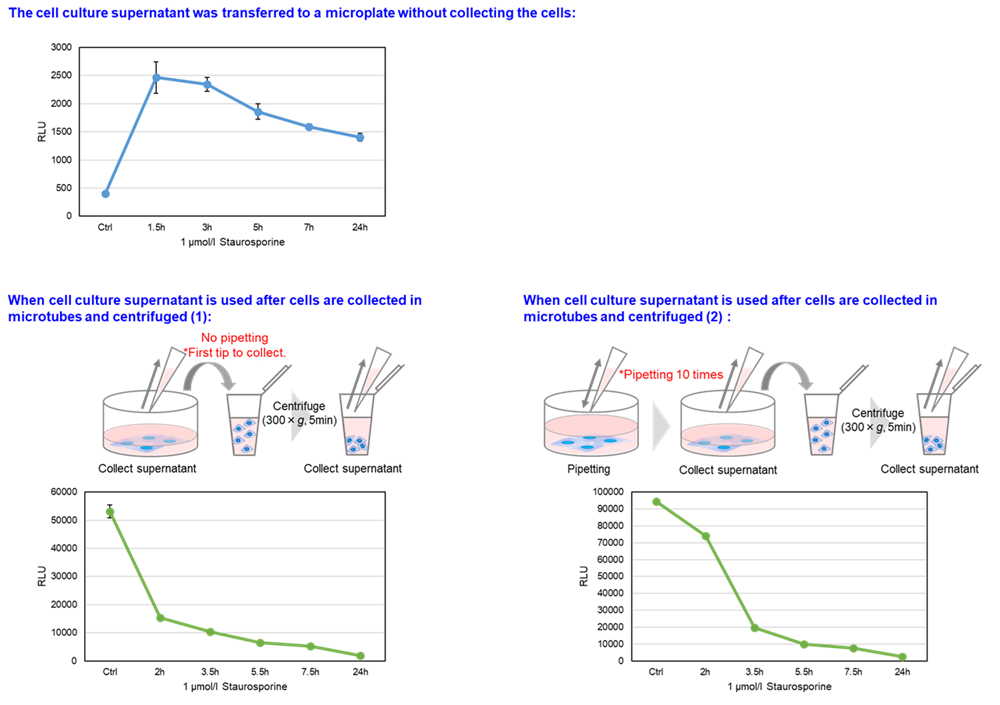
-
Q
Can I use the Extracellular ATP Assay Kit-Luminescence (E299) to measure intracellular ATP levels?
-
A
This kit cannot measure intracellular ATP. If you need to measure intracellular ATP, please use ATP Assay Kit-Luminescence (code: A550).
Handling and storage condition
| Store at 0-5°C |








